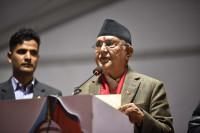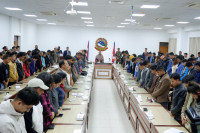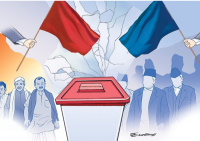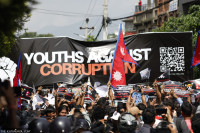Opinion
What of green fields?
Not shielding open spaces from urban encroachment has deprived children of all-round development
Shyam Kc
Soon after the 2015 earthquake, the media was awash with reports of new multi-storey buildings that are soon to dwarf the real landmarks of the once historic city. No sooner did the April earthquake bring down Dharahara—originally built in the early 1830s by the then Prime Minister Bhimsen Thapa under orders of the then Queen Tripura Sundari—than plans were afoot not merely to rebuild it but also to extend its periphery by acquiring other government property. Hopefully, no private property was to be acquired. The sagacity, or lack thereof, of such as a move is yet to be fully assessed.
Then there was the report that Kathmandu Municipality was to build yet another towering structure in the eastern side of Tundhikhel where a long distance bus terminal once was located. The move perhaps stemmed from the fact that the proposal to build a similar structure in the old Kathmandu Municipality site had gone into limbo. The latest media report says that the Nepal Airlines is to bring down its Tundhikhel-based head office building and erect a new structure in its place. Perhaps much in keeping with the Army’s present construction activities, it decided to pull down the majestically breathtaking Tribhuvan-Chandra Army Hospital in front of the Mahankal temple in Tundhikhel. The Army had already pulled down the building but had left the beautiful façade intact lest people find fault with the Army. However, the earthquake effortlessly brought down the front portion since it had no supporting structures.
The craze for new buildings at the cost of the people has been permeating life in the Valley for quite some time now. Times change, and there is nothing new about this. But at what price? The buildings already in place, and the ones being constructed or proposed, are a mismatch in the Valley known for its historic heritage and unique craftsmanship. Granted that our value system is slowly changing to adapt to the western one, even the most liberal political, social and economic systems would reserve a top priority to maintain green areas anywhere in the country. But in our own country, especially in the heart of the Capital, there are hardly any green open areas left. They have all been seized by the government or government-owned entities to erect ugly massive structures.
Selective application of law
If a citizen trespasses and occupies even a small bit of the land in the main thoroughfares, he or she is booked. But when this is done by the government or its subsidiaries, no one raises an eyebrow. To wit, the Trauma Centre built with Indian assistance uses the public footpath; the Nepal Telecom Sundhara building and the Kathmandu Mall owned by the Provident Fund do the same. But who cares? But if you and I do it, we cannot get away with it; the panopticon eye of the government—whoever is in power—sees us do the wrong, but does not see anything wrong in what it does. The law applies to all, including the government, but when selective application is resorted to, it invites wrongdoing in the name of the government. No wonder, the government and the local authorities are doing what they deem fit without an iota of concern for the general public.
As children, we had adequate open green space in the Capital to play and while away time. But these days, we can only become tearful when we see children playing on the streets—some of them busy streets—facing hazards, instead of playing in the green open space, which I believe is their right for proper growth and all-round development. But thanks to the nexus between the builders and authorities, including political leaders, the open spaces are slowly disappearing from the Kathmandu landscape. Instead a large number of shopping complexes, bars and night clubs, many of them in areas that should have been left untouched, have been constructed.
Real estate craze
The Tundhikhel area that once was a huge expanse of greenery is now fragmented and, to top it all, the Kathmandu Municipality is proposing the construction of an underground parking in the Open Air Theatre in Tundhikhel that can accommodate over 1,500 vehicles. What a grand plan! But then, for a municipality that can give a go-ahead to the construction of a massive shopping complex at the site of the Old Bus Park, that is only to be expected, as the local body seems to be filled with those who benefit from such schemes. Perhaps the Commission for the Investigation of Abuse of Authority (CIAA) would do well to delve deep into the real estate craze of the municipality and examine the nexus between some of its officials and the real estate promoters.
Open green spaces, preferably playing fields, are a must in all the wards of the municipalities of the country, especially in thickly populated ones where there are a large number of youngsters who need healthy outlets for their energy. But do our political parties really care for the young? These parties have no qualms about using the young, even small children, to attain their political goals. If the young of today are to lead the country tomorrow, they should be made fully capable and not indoctrinated with politics. And this can only happen when the present crop of leaders show real leadership and vision, and create a political, social and economic atmosphere in which the young can pursue all-round development. Open spaces and playgrounds are an important part of such an environment—a part that should not be neglected and offically encroached upon to build redundant structures. In fact, green fields are useful for people of all ages. Let’s hope that they are not a mere dream and that wisdom will soon dawn on our leaders who these days seem obsessed with power politics.




 16.12°C Kathmandu
16.12°C Kathmandu










